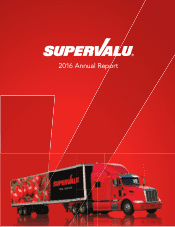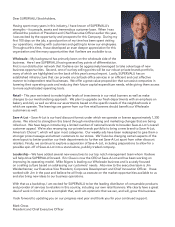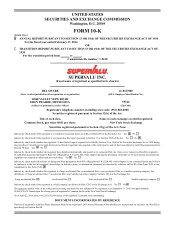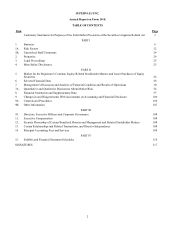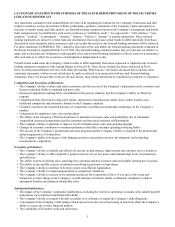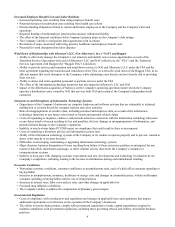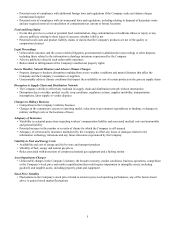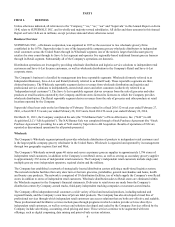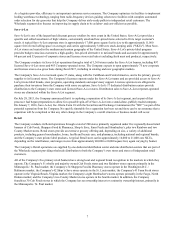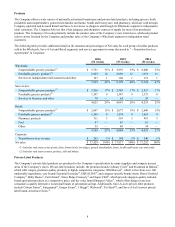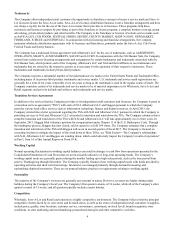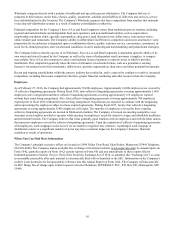Albertsons 2016 Annual Report Download - page 8
Download and view the complete annual report
Please find page 8 of the 2016 Albertsons annual report below. You can navigate through the pages in the report by either clicking on the pages listed below, or by using the keyword search tool below to find specific information within the annual report.6
PART I
ITEM 1. BUSINESS
Unless otherwise indicated, all references to the “Company,” “we,” “us,” “our” and “Supervalu” in this Annual Report on Form
10-K relate to SUPERVALU INC. and its wholly and majority-owned subsidiaries. All dollar and share amounts in this Annual
Report on Form 10-K are in millions, except per share data and where otherwise noted.
Business Overview
SUPERVALU INC., a Delaware corporation, was organized in 1925 as the successor to two wholesale grocery firms
established in the 1870s. Supervalu today is one of the largest public company grocery wholesale distributors to independent
retail customers across the United States through its Wholesale segment, one of the nation’s largest hard discount grocery
retailers by store count through its Save-A-Lot segment and operates five regionally-based traditional format grocery banners
through its Retail segment. Substantially all of the Company's operations are domestic.
Distribution operations are leveraged by providing wholesale distribution and logistics service solutions to independent retail
customers and Save-A-Lot licensee customers, as well as wholesale distribution to the Company's Retail and Save-A-Lot
corporate stores.
The Company’s business is classified by management into three reportable segments: Wholesale (formerly referred to as
Independent Business), Save-A-Lot and Retail (formerly referred to as Retail Food). These reportable segments are three
distinct businesses. The Wholesale reportable segment derives revenues from wholesale distribution and logistics and
professional service solutions to independently-owned retail stores and other customers (collectively referred to as
“independent retail customers”). The Save-A-Lot reportable segment derives revenues from the sale of groceries and other
products at retail locations operated by the Company and from stores licensed to licensees to which the Company provides
wholesale distribution. The Retail reportable segment derives revenues from the sale of groceries and other products at retail
locations operated by the Company.
Supervalu's fiscal year ends on the last Saturday of February. This resulted in a fiscal 2016 52-week year ended February 27,
2016, a fiscal 2015 53-week year ended February 28, 2015 and a fiscal 2014 52-week year ended February 22, 2014.
On March 21, 2013, the Company completed the sale (the “NAI Banner Sale”) of New Albertson’s, Inc. (“NAI”) to AB
Acquisition LLC (“AB Acquisition”). The NAI Banner Sale was completed through a Stock Purchase Agreement (the “Stock
Purchase Agreement”) providing for a sale of NAI stock by Supervalu to AB Acquisition. Results of operations of NAI are
reported as discontinued operations for all periods presented.
Wholesale
The Company’s Wholesale segment primarily provides wholesale distribution of products to independent retail customers and
is the largest public company grocery wholesaler in the United States. Wholesale is organized and operated by its management
through two geographic regions: East and West.
The Company’s Wholesale network spans 40 states and serves as primary grocery supplier to approximately 1,796 stores of
independent retail customers, in addition to the Company’s own Retail stores, as well as serving as secondary grocery supplier
to approximately 232 stores of independent retail customers. The Company’s independent retail customers include single and
multiple grocery store independent operators, regional chains and the military.
The Company has established a network of strategically located distribution centers utilizing a multi-tiered logistics system.
The network includes facilities that carry slow turn or fast turn groceries, perishables, general merchandise and home, health
and beauty care products. The network is comprised of 18 distribution facilities, ten of which supply the Company’s own Retail
stores in addition to stores of independent retail customers. Wholesale distribution sales to Retail stores are eliminated within
the Wholesale segment in the Company's financial statements. Deliveries to retail stores are made from the Company’s
distribution centers by Company-owned trucks, third-party independent trucking companies or customer-owned trucks.
The Company offers independent retail customers a wide variety of food and non-food products, including national and
regional brands, and the Company’s own lines of private label products. The Company has also developed a broad line of
professional services through which independent retail customers can access solutions that are both cost-effective and scalable.
These professional and facilitative services include pass-through programs in which vendors provide services directly to
independent retail customers, as well as services and solutions developed and scaled by the Company. Services offered by the
Company include advertising, accounting, retail pricing and more. These services continue to be augmented with new
offerings, such as digital couponing, data mining and point-of-sale system solutions.

